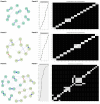Country-specific key lifestyle factors and health outcomes for resource allocation in the general population: a network analysis across 29 countries
- PMID: 39791329
- PMCID: PMC11719263
- DOI: 10.7189/jogh.15.04011
Country-specific key lifestyle factors and health outcomes for resource allocation in the general population: a network analysis across 29 countries
Abstract
Background: We aimed to identify the central lifestyle, the most impactful among lifestyle factor clusters; the central health outcome, the most impactful among health outcome clusters; and the bridge lifestyle, the most strongly connected to health outcome clusters, across 29 countries to optimise resource allocation for local holistic health improvements.
Methods: From July 2020 to August 2021, we surveyed 16 461 adults across 29 countries who self-reported changes in 18 lifestyle factors and 13 health outcomes due to the pandemic. Three networks were generated by network analysis for each country: lifestyle, health outcome, and bridge networks. We identified the variables with the highest bridge expected influence as central or bridge variables. Network validation included nonparametric and case-dropping subset bootstrapping, and centrality difference tests confirmed that the central or bridge variables had significantly higher expected influence than other variables within the same network.
Results: Among 87 networks, 75 were validated with correlation-stability coefficients above 0.25. Nine central lifestyle types were identified in 28 countries: cooking at home (in 11 countries), food types in daily meals (in one country), less smoking tobacco (in two countries), less alcohol consumption (in two countries), less duration of sitting (in three countries), less consumption of snacks (in five countries), less sugary drinks (in five countries), having a meal at home (in two countries), taking alternative medicine or natural health products (in one country). Six central health outcomes were noted among 28 countries: social support received (in three countries), physical health (in one country), sleep quality (in four countries), quality of life (in seven countries), less mental burden (in three countries), less emotional distress (in 13 countries). Three bridge lifestyles were identified in 19 countries: food types in daily meals (in one country), cooking at home (in one country), overall amount of exercise (in 17 countries). The centrality difference test showed the central and bridge variables had significantly higher centrality indices than others in their networks (P < 0.05).
Conclusions: In 29 countries, cooking at home, less emotional distress, and overall amount of exercise emerged as common central lifestyle, health outcome, and bridge lifestyle factors, respectively. However, notable regional variations necessitate tailored interventions and resource allocations to effectively address unique local key variables and promote holistic health in each locale. The study's cross-sectional design and self-reported data may limit generalisability, emphasising the need for cautious interpretation and further longitudinal research.
Keywords: global; across-country comparisons; lifestyle; health outcomes; network analysis.
Copyright © 2025 by the Journal of Global Health. All rights reserved.
Conflict of interest statement
Disclosure of interest: The authors completed the ICMJE Disclosure of Interest Form (available upon request from the corresponding author) and disclose no relevant interests.
Figures


References
-
- Parsamehr M, Rasoulinezhad SP.The study of the relationship between lifestyle and social health among people of Talesh city. Quarterly Journal of Social Development. 2015;10:35–66.
-
- Neupane D, McLachlan CS, Mishra SR, Olsen MH, Perry HB, Karki A, et al. Effectiveness of a lifestyle intervention led by female community health volunteers versus usual care in blood pressure reduction (COBIN): an open-label, cluster-randomised trial. Lancet Glob Health. 2018;6:e66–73. 10.1016/S2214-109X(17)30411-4 - DOI - PubMed
MeSH terms
LinkOut - more resources
Full Text Sources
